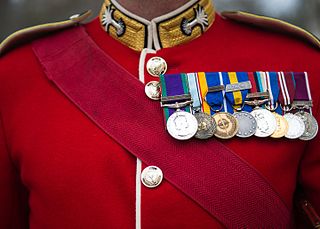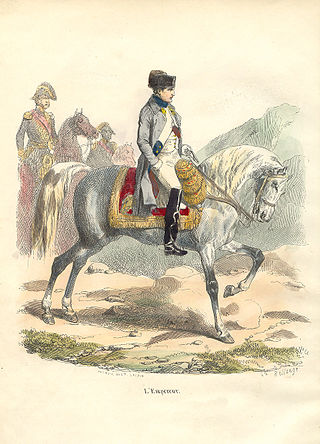
A military uniform is a standardised dress worn by members of the armed forces and paramilitaries of various nations.

Mess dress uniform is the most formal type of evening-wear uniform used by military personnel, police personnel, and other uniformed services members. It frequently consists of a mess jacket, trousers, white dress shirt and a black bow tie, along with orders and medals insignia. Design may depend on regiment or service branch, e.g. army, navy, air force, marines, etc. In modern Western dress codes, mess dress uniform is the supplementary alternative equivalent to the civilian black tie for evening wear. Mess dress uniforms are typically less formal than full dress uniform, but more formal than service dress uniform.

The Buffs (Royal East Kent Regiment), formerly the 3rd Regiment of Foot, was a line infantry regiment of the British Army traditionally raised in the English county of Kent and garrisoned at Canterbury. It had a history dating back to 1572 and was one of the oldest regiments in the British Army, being third in order of precedence (ranked as the 3rd Regiment of the line). The regiment provided distinguished service over a period of almost four hundred years accumulating one hundred and sixteen battle honours. In 1881, under the Childers Reforms, it was known as the Buffs (East Kent Regiment) and later, on 3 June 1935, was renamed the Buffs (Royal East Kent Regiment).

Imperial Japanese Army uniforms tended to reflect the uniforms of those countries who were the principal advisors to the Imperial Japanese Army at the time.

Full dress uniform, also known as a ceremonial dress uniform or parade dress uniform, is the most formal type of uniforms used by military, police, fire and other public uniformed services for official parades, ceremonies, and receptions, including private ones such as marriages and funerals. Full dress uniforms typically include full-size orders and medals insignia. Styles tend to originate from 19th century uniforms, although the 20th century saw the adoption of mess dress-styled full-dress uniforms. Designs may depend on regiment or service branch. In Western dress codes, full dress uniform is a permitted supplementary alternative equivalent to the civilian white tie for evening wear or morning dress for day wear – sometimes collectively called full dress – although military uniforms are the same for day and evening wear. As such, full dress uniform is the most formal uniform, followed by the mess dress uniform.
The uniforms of the Canadian Armed Forces are the official dress worn by members of Canada's military while on duty.

Red coat, also referred to as redcoat or scarlet tunic, is a military garment formerly much used by British infantrymen, so customarily that the term became a common synecdoche for the soldiers themselves.

The uniforms of La Grande Armée, the army of Napoleon I, are described in this article.

The uniforms of the British Army currently exist in twelve categories ranging from ceremonial uniforms to combat dress. Uniforms in the British Army are specific to the regiment to which a soldier belongs. Full dress presents the most differentiation between units, and there are fewer regimental distinctions between ceremonial dress, service dress, barrack dress and combat dress, though a level of regimental distinction runs throughout.

Gorget patches are an insignia in the form of paired patches of cloth or metal on the collar of a uniform (gorget), used in the military and civil service in some countries. Collar tabs sign the military rank, the rank of civil service, the military unit, the office (department) or the branch of the armed forces and the arm of service.

Service Dress is the style of khaki service dress uniform introduced by the British Army for use in the field from the early 1900s, following the experiences of a number of imperial wars and conflicts, including the Second Boer War. This variant of uniform continues to be worn today, although only in a formal role, as No. 2 Pattern dress.
The uniforms of the United States Army distinguish soldiers from other service members. U.S. Army uniform designs have historically been influenced by British and French military traditions, as well as contemporary U.S. civilian fashion trends. The two primary uniforms of the modern U.S. Army are the Army Combat Uniform, used in operational environments, and the Army Green Service Uniform, worn during everyday professional wear and during formal and ceremonial occasions that do not warrant the wear of the more formal blue service uniform.

The modern Greek Army has a history of almost 200 years, during which it has undergone dramatic changes and been involved in some of the major conflicts on the European continent. The modern Greek military throughout its history was closely following international developments in equipment and uniforms. With the notable exception of the elite Evzones units, which based their uniforms on the indigenous traditional garments of the 18th century, the rest of the Army, as most militaries worldwide, was always quick to adopt the military fashion current among the armies of the influential Great Powers. This influence can be roughly divided in three periods: French-style uniforms, which dominated throughout the 19th century, the British styles introduced around World War I and used during World War II and until the late 1960s, and the "NATO" or US-style predominating from ca. 1968 onward. Various individual items or details can of course be traced to other influences, and there were also transitional uniforms combining previous designs.
The military uniforms of the Union Army in the American Civil War were widely varied and, due to limitations on supply of wool and other materials, based on availability and cost of materials. The ideal uniform was prescribed as a dark blue coat with lighter pants, with a black hat. Officer's ranks were denoted with increasing levels of golden decoration. Specific jobs, companies, and units had markedly different styles at times, often following European customs such as that of the Zouaves. Officers uniforms tended to be highly customized and would stray from Army standard. Ironically, several main pieces of gear had been created by order of the U.S. War Secretary Jefferson Davis before the war; he later became Confederate President.

Troops began wearing berets as a part of the headgear of military uniforms in some European countries during the 19th century; since the mid-20th century, they have become a component of the uniforms of many armed forces throughout the world. Military berets are usually pushed to the right to free the shoulder that bears the rifle on most soldiers, but the armies of some countries, mostly within Europe, South America, and Asia, have influenced the push to the left.

The Royal Marines uniform is the standardised military dress worn by members of the Royal Marines.
British Army mess dress is the formal military evening dress worn by British Army officers and senior non-commissioned officers in their respective messes or at other formal occasions.
The Napoleonic Wars was a series of wars lasting from 1803 to 1815. Spain was just one of the many countries which resisted the expansion of the French Empire under Napoleon I. The general population fought as guerrillas, preventing the occupying French forces from obtaining supplies or safe passage.

The Uniforms of the Royal Danish Army distinguish soldiers from other service members. Royal Danish Army uniforms were originally influenced by French, Prussian and Russian military traditions. However, in more recent times, its uniforms have been characterized as being influenced by British uniforms, and, more significantly, American uniforms.
This is an outline of the British Army's light cavalry during the Napoleonic Wars, which consisted of the Light Dragoons and later Hussars, and from 1816 the lancers.



















